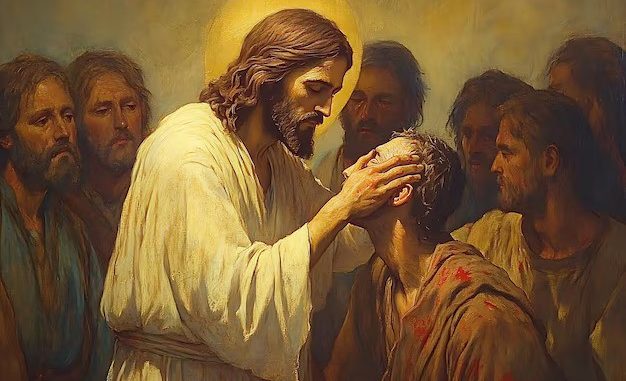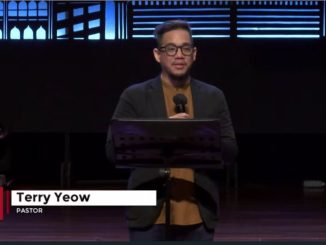
Jesus performed numerous miracles during His time on Earth, and many of them had a profound underlying deeper meaning. In Mark 8:22-26, we read about one of the most noteworthy of these, where Jesus heals a blind man in Bethsaida. The remarkable thing about this miracle is that it wasn’t just about physical healing. The healing of this blind man went beyond the natural into the supernatural, and through this miracle, we also see a picture of how God gradually opens our spiritual eyes, and how we grow into spiritual maturity.
Last Sunday at Georgetown Baptist Church in Penang, Bro Lim Thiam Ern shared a sober and powerful message on this passage, highlighting the deeper significance of Jesus’ miracle. What can we learn from it about growing in faith and seeing with spiritual clarity?

The Process of Healing and Growth
In his gospel, the evangelist and apostle Mark records a unique miracle where Jesus heals a blind man in stages rather than instantly. The account begins with people bringing a blind man to Jesus, begging Him to heal him with a touch. Their expectation was simple – they had seen or heard of Jesus healing through physical touch before and assumed this would be the case again. But Jesus did something unexpected: He took the man by the hand and led him out of the village.

The healing process itself was equally distinctive. Jesus spat on the man’s eyes, laid His hands on him, and asked whether he saw anything. The man responded that he saw people, but they looked like trees walking – his vision was partially restored but still unclear. Then Jesus laid His hands on him again, and his sight was fully restored. Finally, He instructed the man not to return to the village.

Mark’s account highlights several key truths. Jesus’ decision to lead the man away from the village shows that healing is not about public spectacle but personal transformation. Sometimes, God removes us from familiar surroundings to work in us privately, away from distractions.
The gradual healing reminds us that spiritual growth is often a process. While we may long for instant clarity, God reveals His plans step by step, refining us through patience and faith. The second touch emphasizes that complete healing – whether physical, emotional, or spiritual – comes in God’s perfect timing. Just as the blind man needed another touch, we, too, may require ongoing encounters with Jesus to gain full clarity in our walk of faith. This miracle reassures us of God’s faithful and patient work in us, unfolding according to His divine purpose.
Jesus Decides the Miracles, Not Us
Many myths and misconceptions about miracles have been debunked, and it is crucial to understand this plain and clear: Jesus alone decides when, where, how, and whether a miracle occurs. In Mark 8:11-13, Jesus outright rejected the Pharisees’ demand for a sign. He does not perform miracles for spectacle or validation but according to His will and purpose.
When Jesus took the blind man by the hand and led him away from the village, the crowd must have been puzzled. They might have questioned why the healing did not happen instantly. Some might have speculated that Jesus needed more power or time. However, none of that is true. Jesus deliberately chose the moment, method, and setting of the healing. This teaches us that miracles are not formulas to be replicated, nor can they be commanded by human effort, as seen in Acts 19 when the seven sons of Sceva attempted to cast out demons in Jesus’ name and failed miserably.

Christians sometimes fall into the trap of seeking a “special” way to pray or a particular person to intercede, believing that certain prayers are more powerful. Bro Lim expressed that faith should rest solely on God, not on people or objects, no matter how significant they seem. As Job demonstrated, true faith acknowledges that God gives and takes away, and our response should be worship.
God can use the simplest, most unexpected means to accomplish His will. Jesus used spit and mud to heal – methods that seem strange to us but serve to emphasize that the power comes from Him alone. Scientists may attempt to create life, but they still rely on pre-existing materials. Only God creates from nothing, demonstrating His supreme authority.

Ultimately, Jesus prioritizes a relationship with us over resolving our problems. He walked with the blind man before healing him, showing that knowing Him is more important than immediate relief from suffering. Our greatest need is not just physical healing or problem-solving but an intimate, daily connection with Jesus. Without it, even the joy of a miracle fades as life’s challenges return. This truth is highlighted in yet another well-known miracle; the raising of Lazarus from the dead.
Lazarus: A Miracle and a Challenge
Just as the blind man’s healing was a process, another miracle – the raising of Lazarus – reveals an important truth: miracles do not exempt us from challenges but point us to a deeper relationship with Christ. Lazarus was raised from the tomb after being dead for four days, showcasing the power of Christ over death. Imagine his initial joy – being reunited with loved ones, experiencing life again. However, this joy was short-lived.

John 12:9-11 reveals that the chief priests and Pharisees sought to kill Lazarus. His miraculous resurrection made him a living testimony of Jesus’ divine power, which threatened their authority. Historical accounts suggest that Lazarus fled to Cyprus, where an ancient tomb in Larnaca bears an inscription: Lazarus, four days dead, friend of Christ. His life after the miracle was filled with adversity. Lazarus’s miracle was also a challenge, reminding us of Jesus’ words in John 16:33: “In this world you will have trouble. But take heart! I have overcome the world.”
The Journey of Spiritual Sight
The Christian life is a journey filled with highs and lows. Like all journeys, it can be full of challenges, both spiritual and physical. Have you ever struggled to see God’s plan clearly? The disciples, despite witnessing countless miracles, struggled to grasp Jesus’ true identity. Like the disciples, we also often see dimly before understanding fully. Once again, in moments like these, the healing of the blind man reminds us that spiritual clarity is often a process, not an instant revelation. And just like with Lazarus, we may find that miracles do not exempt us from difficulties.

Spiritual maturity comes with the journey. Just as Jesus healed a blind man in stages, our understanding of Him grows over time. The greatest gift of Christianity is not in outward signs and wonders, but in an intimate relationship with Christ. Without Jesus, we cannot truly know God.
What We Can Learn through the Blind Man in Bethsaida
The blind man did not settle for partial healing; he longed for full restoration. Likewise, we too must yearn for a complete and unwavering faith and actively seek spiritual growth. This requires commitment – dedicating time, energy, and resources to know Christ more deeply.

It is encouraging to know that Jesus began the healing journey of the blind man because He understood his need – just as He understands ours. True satisfaction is found not in worldly possessions but in a deep, personal relationship with Christ. As we follow Him, we discover that His presence fulfills every aspect of our lives. Like the blind man in Bethsaida, may we not settle for partial vision but seek Christ continually until we see with full spiritual clarity.
This is a coverage article on a sermon preached by Brother Lim Thiam Eern at Georgetown Baptist Church, Penang on the 23rd of March 2025, written from the lens of the impartation the writer has received from the sermon. It is an independent initiative and is not directly affiliated with Georgetown Baptist Church.
|Share The Good News|




Leave a Reply